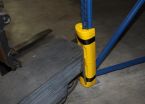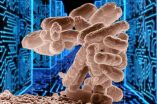(Press-News.org) At the end of a long day on the job, the warehouse employee wants to deposit the last palettes quickly before heading home. With a little too much momentum he steers his forklift toward the shelf and collides with a shelf support. This is an every- day situation in large warehouses in which employees often have to maneuver goods through the narrow aisles, often under time pressure. Even harmless-seeming collisions are not really safe though, because over time they may in fact destabilize the shelf supports. In the worst case, the high-rack storage can come crashing down – a serious hazard for the employees below. This is why the supports must be routinely checked for any damage. Up until now, an employee has to inspect each shelf individually – a laborious and time-consuming process. A further drawback: If a support is damaged immediately after an inspection, it goes undetected until the next round. A more effective and reliable protection is afforded by a new monitoring system developed by researchers at the Fraunhofer Institute for Microelectronic Circuits and Systems IMS in Duisburg, in collaboration with IWS Handling GmbH. With the aid of a network of wireless sensors, the condition of each individual support can be monitored around the clock. "Since DIN EN 15635 was introduced, the demands on the operation of shelf systems have increased significantly. Regular inspections have become indispensable as a result," according to Dr. Weiner, managing director at IWS Handling.
Typically, to protect them from collisions, the supports are fitted with a kind of air cushion designed to absorb the impact. "We have integrated sensors in this protective fitting that measure the pressure within the air cushion," explains Frederic Meyer, project manager at IMS. If an air cushion is collided with, the sensor registers the change in interior pressure and reports this via radio relay to a central control station. This is located in the warehouse manager's office. Repeaters positioned at several points throughout the warehouse receive the messages from the sensor nodes and smoothly pass these along to the control station. All the warehouse manager needs to do is glance at the base station to know when and where the last collisions took place within the hall. The system automatically provides him or her a report of whether the impact was harmless, of medium strength or serious. While no immediate measures are required for light collisions, in the event of a category three incident the warehouse manager immediately will send an employee to the shelf in question.
Energy management played a central role in developing this new technology. "After all, the use of such a system only pays off if you aren't constantly having to replace the batteries in the sensors," Meyer adds. The researchers in Duisburg have configured the system so that the electronics spend most of their time in energy-saving sleep mode. Only when a fluctuation in pressure occurs do the sensor nodes "wake up" and switch to active status. At certain intervals, though – the settings can be varied individually – each sensor node sends a "sign of life" along with its current battery status to a repeater. This ensures that the failure of a signal node will not go unnoticed and is reported to the control station.
The scientists expect to have realized a first demonstrator model by the end of March, which they will then present at the Euro ID (April 5-7 in Berlin) and Sensor + Test (June 7-9 in Nuremberg) trade fairs. A field test is planned for a larger warehouse facility as well. The project is sponsored by the "Otto von Guericke" German Federation of Industrial Research Associations.
INFORMATION:
Crash sensor boosts safety in warehouses
2011-04-29
ELSE PRESS RELEASES FROM THIS DATE:
NIH study finds Avastin and Lucentis are equally effective in treating AMD
2011-04-29
Researchers are reporting results from the first year of a two-year clinical trial that Avastin, a drug approved to treat some cancers and that is commonly used off-label to treat age-related macular degeneration (AMD), is as effective as the Food and Drug Administration-approved drug Lucentis for the treatment of AMD.
The report, from the Comparison of AMD Treatments Trials (CATT), was published online in the New England Journal of Medicine on Sunday, May 1, 2011. CATT is funded by the National Eye Institute (NEI), a part of the National Institutes of Health.
"Over ...
Extreme testing for rotor blades
2011-04-29
Only when you are standing beside a wind turbine can you appreciate the immense size of the wind turbine and its rotor blades. The largest wind turbines operating in the world today have rotor blades over 60 meters long – roughly equivalent to three truck-and-trailer units end-to-end. Within the next ten years, manufacturers of high-output wind turbines for offshore wind farms plan to produce blades up to 90 meters long. The prototypes of these new blades have to be tested and certified before they can go into production, and that requires equally as large testing facilities.
The ...
Taking safety personally
2011-04-29
A year after the BP explosion and oil spill, those trying to find someone to blame are misguided, says psychological scientist E. Scott Geller, Alumni Distinguished professor at Virginia Tech, and author of a new paper published in Current Directions in Psychological Science, a journal of the Association for Psychological Science. Geller has spent much of his 42-year career developing interventions to keep people safe, particularly helping companies develop a culture that promotes occupational safety.
There's almost never one person to blame for an injury; instead, companies ...
Inverting a standard experiment sometimes produces different results
2011-04-29
Nanoparticles will soon be used as tiny shuttles to deliver genes to cells and drugs to tumors in a more targeted way than was possible in the past.
But as the scientists prepare to use the nanoparticles in medicine, concerns have arisen about their potential toxicity.
Studies of both the applications of nanoparticles and their toxicity rely on the ability of scientists to quantify the interaction between the nanoparticles and cells, particularly the uptake (ingestion) of nanoparticles by cells.
In the standard laboratory tests of the biological activity of nanoparticles, ...
Fish livers contain beneficial fatty acids
2011-04-29
The fishing industry usually discards fish livers, but a team of researchers from the University of Almeria (Spain) has confirmed that they are a good source of polyunsaturated fatty acids, which are beneficial to health. Anchovies are one of the fish whose livers contain the highest levels of these substances.
Fish livers have hardly been used to date, with exceptions such as cod livers, which are used to produce the well-known medicinal oil. In general, fishermen tend to throw fish entrails away into the sea, and if they make it to processing plants they are one of ...
Dr. Michael Collins publishes paper on ivory-billed woodpecker
2011-04-29
Dr. Michael Collins, Naval Research Laboratory scientist and bird watcher, has published an article titled "Putative audio recordings of the Ivory-billed Woodpecker (Campephilus principalis)" which appears in the March issue of the Journal of the Acoustical Society of America. The audio recordings were captured in two videos of birds with characteristics consistent with the Ivory-billed Woodpecker. This footage was obtained near the Pearl River in Louisiana, where there is a history of unconfirmed reports of this species. During five years of fieldwork, Collins had ten ...
New insight into chromosome segregation: Centromere-independent kinetochore assembly
2011-04-29
One of the most critical tasks that a dividing cell must accomplish is the successful delivery of a complete set of genetic information to each new daughter cell. Now, a study published by Cell Press in the April 29th issue of the journal Cell, provides fascinating new insight into the complex of proteins that orchestrates the proper segregation of human chromosomes during cell division.
During the process of mitosis, DNA and its associated packing proteins are arranged into structures called chromosomes that are duplicated and then segregated. Duplicated chromosomes ...
Nanotechnologists must take lessons from nature
2011-04-29
It's common knowledge that the perfect is the enemy of the good, but in the nanoscale world, perfection can act as the enemy of the best.
In the workaday world, engineers and scientists go to great lengths to make the devices we use as perfect as possible. When we flip on a light switch or turn the key on the car, we expect the lights to come on and the engine to start every time, with only rare exceptions. They have done so by using a top-down design process combined with the application of large amounts of energy to increase reliability by suppressing natural variability.
However, ...
Era of canopy crane ending; certain research and education activities remain
2011-04-29
The 25-story construction crane used since 1995 to investigate such things as how Pacific Northwest forests absorb carbon dioxide, obtain sufficient water and resist attacks by pests and diseases is being pruned back to just the tower.
The Wind River Canopy Crane, located in a 500-year-old forest near Stevenson in southwest Washington, has been operated cooperatively by the University of Washington, the Forest Service's Pacific Northwest Research Station and the Gifford Pinchot National Forest. The partners say the jib – the arm of the crane – is being removed because ...
Pediatric flu vaccination: Understanding low acceptance rates could help increase coverage
2011-04-29
A study of H1N1 and seasonal influenza vaccination in a sample of black and Hispanic children in Atlanta found a low rate of vaccine acceptance among parents and caregivers. Only 36 percent of parents and caregivers indicated they would immunize children against H1N1, and 22 percent indicated their children received the seasonal influenza vaccine in the previous three months. The majority of children in the sample (71 percent) were from households with less than $40,000 in annual income.
Researchers say this low level of vaccine coverage and acceptance highlights the ...






